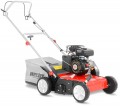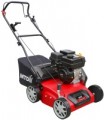Type
The type determines the method of operation and, accordingly, the general purpose and specific application of the aerator.
—
Verticutter(knife). The name comes from the English "vertical cutter" — "vertical blade". In accordance with this, the working tool of the verticutter is a horizontal shaft with vertical blades mounted on it. In the process of work, such an aggregate leaves characteristic slots in the ground, which contribute to the penetration of air, moisture and nutrients into the soil. In this case, the blades cut the roots of the grass, thus stimulating their growth in loosened soil and, accordingly, the growth of the grass itself. In addition, verticutters are good (better than the
scarifiers described below) for removing debris from the surface of the earth. They easily cope with both “lying” debris like wood chips or acorns, as well as with dry grass, moss cover, etc. Therefore, the main purpose of such units is the cleaning of neglected lawns that have not been cultivated for a long time, which require intensive processing. It should be noted that verticutters also include hand-held devices (see "Engine type") with a working tool in the form of characteristic "sprocket" wheels: according to the specifics of work, they are a cross between rake and knife models, however, the teeth of the "sprockets" are more similar on knives than on the antennae of scarifiers, and they penetrate deeper
....
— Scarifier (rake). Aerators of this type work on the principle of a wire rake: like verticutters, they use a working tool in the form of a shaft, but not blades are installed on the shaft, but wire “antennae”. Thus, most scarifiers do not so much work on the soil as they comb the lawn, removing debris from it — like last year's leaves or dry grass. However, there are models that are able to pierce the soil; however, even with them, the depth of influence is very small — up to 5 mm. In general, such units are designed mainly to maintain healthy already “cultivated” lawns that do not require intensive processing.
— Combined. Models that can be used both as a knife aerator and as a rake aerator. Features of both types are described in detail above. And to realize their functions in one aerator, it is possible through the use of interchangeable shafts: by installing the appropriate shaft, the owner can turn the unit either into a verticutter or a scarifier. Note that only those units that are initially equipped with working tools of different types belong to the combined ones. If the possibility of replacement is provided, but there is only one shaft in the kit, the aerator will be assigned to one of the types described above.Max. processing depth
The greatest depth to which the aerator nozzle is able to penetrate the ground during operation.
This parameter is relevant primarily for models that support verticutter functions (see "Type") — the very format of operation of such units implies "biting" into the ground. For scarifiers, the processing depth is often not indicated at all, because. they work mostly above the surface.
Max. processing height
The highest processing height provided by the aerator.
This parameter describes the maximum height above the lawn surface that the working head can be raised to. It is of practical importance only for models with scarifier functions (see "Type"): it is this type of aerator that allows you to leave the space between the working nozzle and the soil surface untouched during operation. This can be useful, for example, when removing debris from a previously fertilized lawn. But in the case of verticutters, the maximum height only affects the convenience of transportation: the higher the nozzle can be raised, the higher obstacles the unit can overcome without hitting it with knives.
Shaft speed
Rotation speed of the aerator shaft in normal operation.
Manufacturers select the shaft speed in such a way that the device is guaranteed to be able to cope with the tasks for which it is designed. So in most cases, this parameter is more of a reference than practically significant. At the same time, for verticutters (see "Type"), it can also have a practical meaning: lower speed, with the same power, provides higher tractive effort and allows you to better cope with dense soils and thick rhizomes. So for such conditions, it is worth choosing a model with lower revolutions, and for a favorable environment, on the contrary, higher (high revolutions have a positive effect on performance).
Self-propelled
In accordance with the name, models with this feature
move themselves during operation, which relieves the operator of the need to push the unit in front of him and facilitates work. This is especially important for high-performance aerators that have significant weight. On the other hand, self-propelled devices are noticeably more expensive than non-self-propelled ones, consume more fuel / energy and require more powerful engines — after all, part of the power must be directed to ensure movement, while in non-self-propelled structures it can all be used on the working shaft.
Working mechanism
The design of the working mechanism provided in the aerator, in other words, the number and types of working elements installed on the shaft. For verticutters (see "Type") such elements are blades, for scarifiers — spring teeth. For
combined models, in this case, the design of both working shafts is indicated, for example "14 knives / 20 spring teeth".
Bag volume
The total volume of the garbage collection bag provided with the aerator.
The larger the bag, the more garbage it can hold, the less often it will have to be emptied. On the other hand, the weight and dimensions of a capacious container will also be considerable (this is especially true for rigid varieties, in which the size does not depend on fullness — see "Bag Type"). Yes, and carrying too much garbage “with you” is not always convenient, especially with the small size and weight of the unit itself. Therefore, manufacturers, usually, choose this parameter taking into account the specifics of the use of the aerator. So, in low-power models designed for small areas, the volume of the bag is also small, and in high-performance professional devices it can exceed 50 liters.
Handle height adjustment
The ability
to change the height of the aerator handle. This feature makes it possible to adjust the unit to the height of the user in order to ensure comfort and reduce fatigue.
Engine size
The volume of the petrol engine installed in the corresponding type of aerator (see "Engine type"). Usually, the larger the engine (with the same type of internal combustion engine, see above) — the higher its power and the more fuel it consumes. In general, this parameter is for reference: manufacturers select it in such a way as to provide the necessary practical characteristics (in particular, the same power).

